International Trade, Transport Infrastructure in India: A Report
VerifiedAdded on 2019/12/03
|13
|3605
|139
Report
AI Summary
This report presents a comprehensive analysis of India's international trade, focusing on key trends in the global market, the influence of transport infrastructure on trade development, and associated transport-related activities. The report examines the evolution of international trade, highlighting the significance of exports in India's economic growth and the role of various transport modes such as roads, railways, ports, and airlines. It delves into the opportunities and challenges faced by India's transport and logistics sector, including government initiatives, the involvement of private companies, and the impact of emerging technologies. The report also discusses the impact of globalization, liberalization of cross-border movements, and the growth of emerging markets on India's trade dynamics, providing insights into the country's import and export patterns. The study concludes by assessing the key transport-related opportunities and challenges that will shape the development of international trade in India over the next two decades, considering factors such as government policies, private sector involvement, and industry trends.
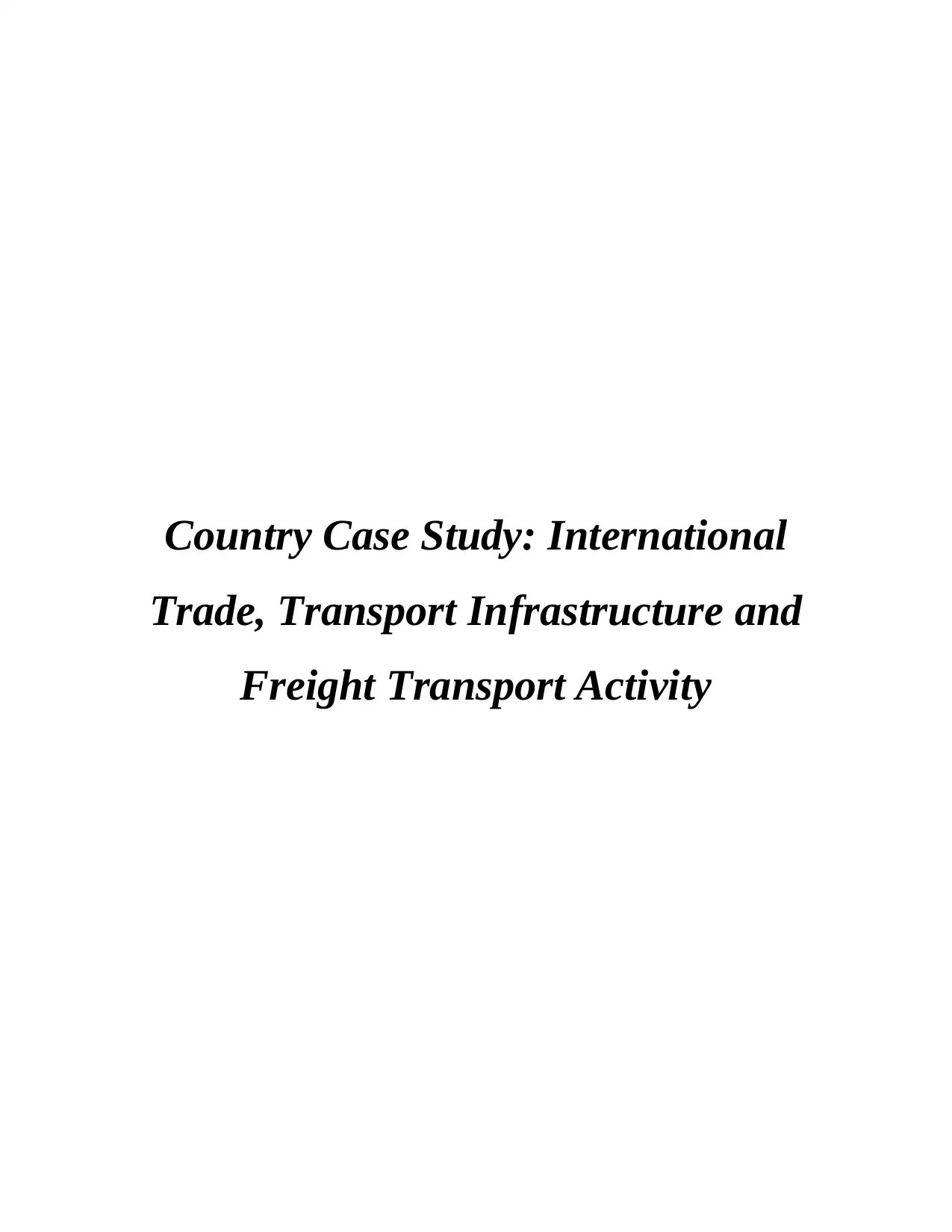
Country Case Study: International
Trade, Transport Infrastructure and
Freight Transport Activity
Trade, Transport Infrastructure and
Freight Transport Activity
Paraphrase This Document
Need a fresh take? Get an instant paraphrase of this document with our AI Paraphraser
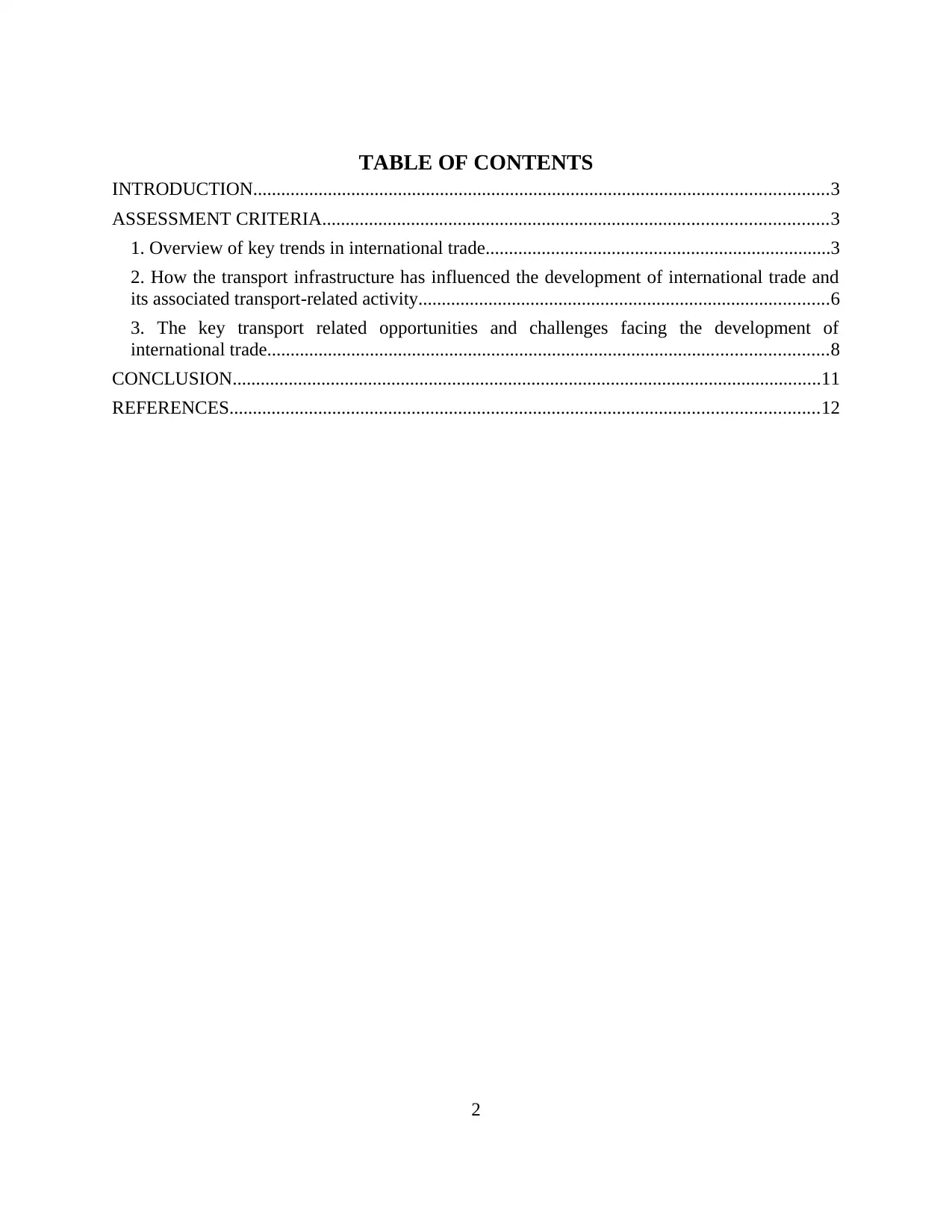
TABLE OF CONTENTS
INTRODUCTION...........................................................................................................................3
ASSESSMENT CRITERIA............................................................................................................3
1. Overview of key trends in international trade..........................................................................3
2. How the transport infrastructure has influenced the development of international trade and
its associated transport-related activity........................................................................................6
3. The key transport related opportunities and challenges facing the development of
international trade........................................................................................................................8
CONCLUSION..............................................................................................................................11
REFERENCES..............................................................................................................................12
2
INTRODUCTION...........................................................................................................................3
ASSESSMENT CRITERIA............................................................................................................3
1. Overview of key trends in international trade..........................................................................3
2. How the transport infrastructure has influenced the development of international trade and
its associated transport-related activity........................................................................................6
3. The key transport related opportunities and challenges facing the development of
international trade........................................................................................................................8
CONCLUSION..............................................................................................................................11
REFERENCES..............................................................................................................................12
2
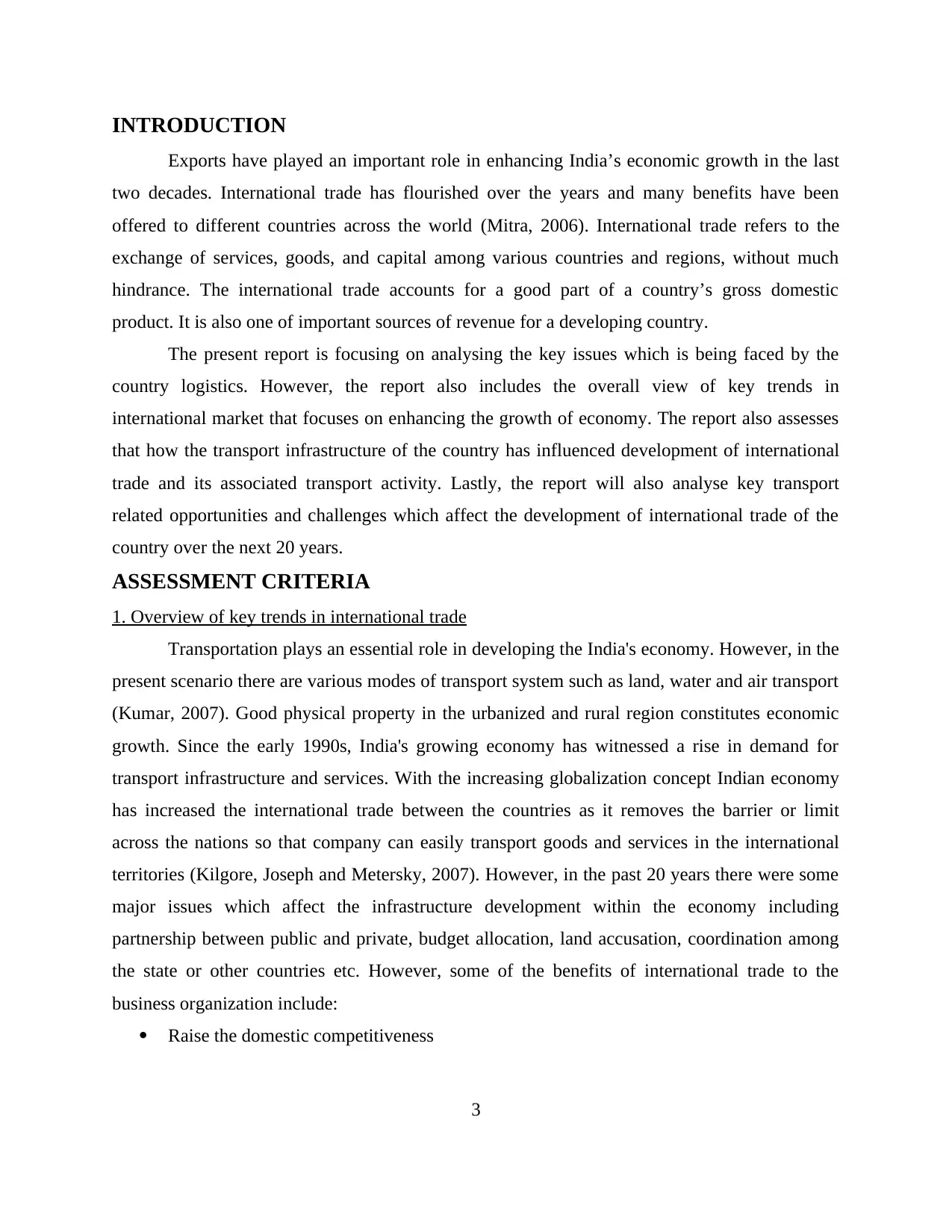
INTRODUCTION
Exports have played an important role in enhancing India’s economic growth in the last
two decades. International trade has flourished over the years and many benefits have been
offered to different countries across the world (Mitra, 2006). International trade refers to the
exchange of services, goods, and capital among various countries and regions, without much
hindrance. The international trade accounts for a good part of a country’s gross domestic
product. It is also one of important sources of revenue for a developing country.
The present report is focusing on analysing the key issues which is being faced by the
country logistics. However, the report also includes the overall view of key trends in
international market that focuses on enhancing the growth of economy. The report also assesses
that how the transport infrastructure of the country has influenced development of international
trade and its associated transport activity. Lastly, the report will also analyse key transport
related opportunities and challenges which affect the development of international trade of the
country over the next 20 years.
ASSESSMENT CRITERIA
1. Overview of key trends in international trade
Transportation plays an essential role in developing the India's economy. However, in the
present scenario there are various modes of transport system such as land, water and air transport
(Kumar, 2007). Good physical property in the urbanized and rural region constitutes economic
growth. Since the early 1990s, India's growing economy has witnessed a rise in demand for
transport infrastructure and services. With the increasing globalization concept Indian economy
has increased the international trade between the countries as it removes the barrier or limit
across the nations so that company can easily transport goods and services in the international
territories (Kilgore, Joseph and Metersky, 2007). However, in the past 20 years there were some
major issues which affect the infrastructure development within the economy including
partnership between public and private, budget allocation, land accusation, coordination among
the state or other countries etc. However, some of the benefits of international trade to the
business organization include:
Raise the domestic competitiveness
3
Exports have played an important role in enhancing India’s economic growth in the last
two decades. International trade has flourished over the years and many benefits have been
offered to different countries across the world (Mitra, 2006). International trade refers to the
exchange of services, goods, and capital among various countries and regions, without much
hindrance. The international trade accounts for a good part of a country’s gross domestic
product. It is also one of important sources of revenue for a developing country.
The present report is focusing on analysing the key issues which is being faced by the
country logistics. However, the report also includes the overall view of key trends in
international market that focuses on enhancing the growth of economy. The report also assesses
that how the transport infrastructure of the country has influenced development of international
trade and its associated transport activity. Lastly, the report will also analyse key transport
related opportunities and challenges which affect the development of international trade of the
country over the next 20 years.
ASSESSMENT CRITERIA
1. Overview of key trends in international trade
Transportation plays an essential role in developing the India's economy. However, in the
present scenario there are various modes of transport system such as land, water and air transport
(Kumar, 2007). Good physical property in the urbanized and rural region constitutes economic
growth. Since the early 1990s, India's growing economy has witnessed a rise in demand for
transport infrastructure and services. With the increasing globalization concept Indian economy
has increased the international trade between the countries as it removes the barrier or limit
across the nations so that company can easily transport goods and services in the international
territories (Kilgore, Joseph and Metersky, 2007). However, in the past 20 years there were some
major issues which affect the infrastructure development within the economy including
partnership between public and private, budget allocation, land accusation, coordination among
the state or other countries etc. However, some of the benefits of international trade to the
business organization include:
Raise the domestic competitiveness
3
⊘ This is a preview!⊘
Do you want full access?
Subscribe today to unlock all pages.

Trusted by 1+ million students worldwide
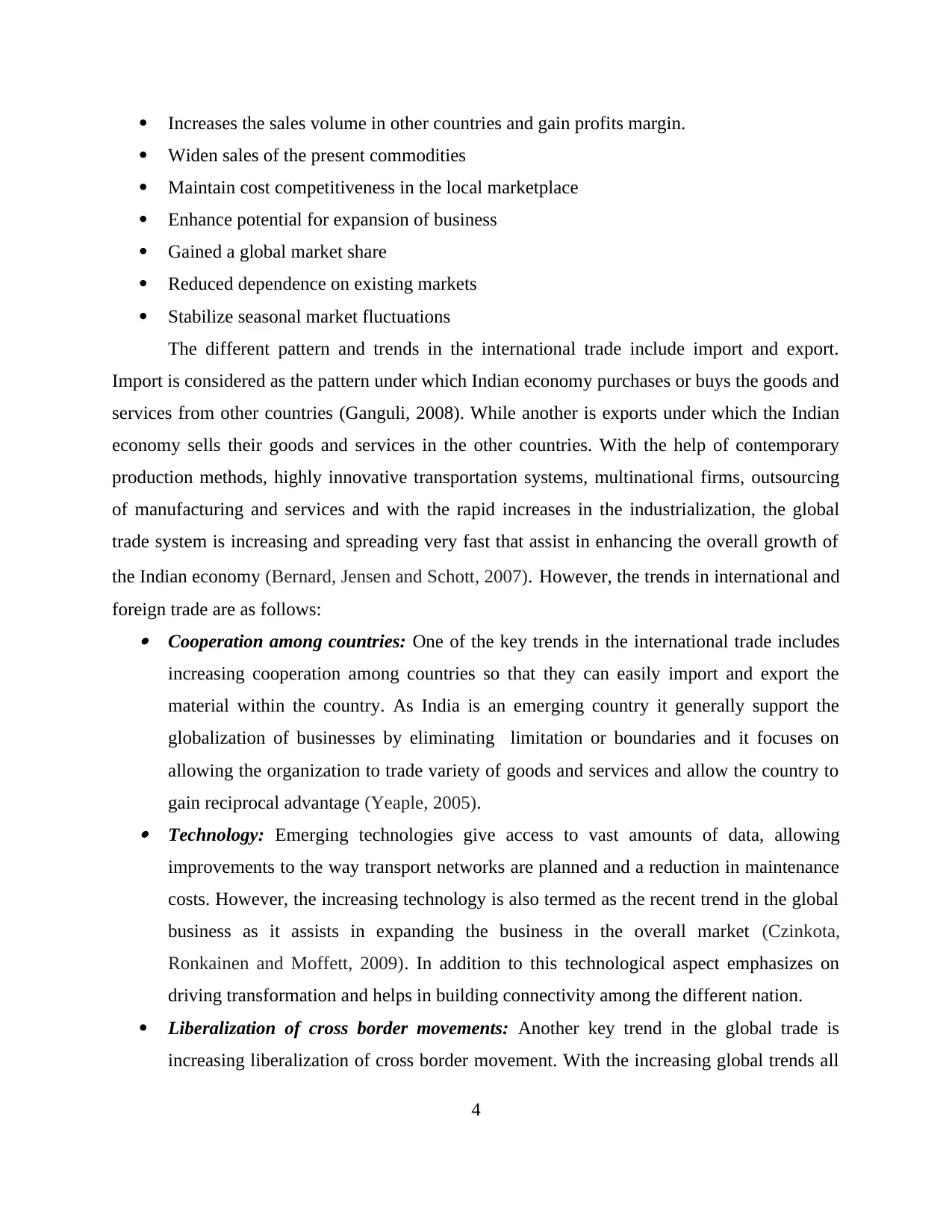
Increases the sales volume in other countries and gain profits margin.
Widen sales of the present commodities
Maintain cost competitiveness in the local marketplace
Enhance potential for expansion of business
Gained a global market share
Reduced dependence on existing markets
Stabilize seasonal market fluctuations
The different pattern and trends in the international trade include import and export.
Import is considered as the pattern under which Indian economy purchases or buys the goods and
services from other countries (Ganguli, 2008). While another is exports under which the Indian
economy sells their goods and services in the other countries. With the help of contemporary
production methods, highly innovative transportation systems, multinational firms, outsourcing
of manufacturing and services and with the rapid increases in the industrialization, the global
trade system is increasing and spreading very fast that assist in enhancing the overall growth of
the Indian economy (Bernard, Jensen and Schott, 2007). However, the trends in international and
foreign trade are as follows: Cooperation among countries: One of the key trends in the international trade includes
increasing cooperation among countries so that they can easily import and export the
material within the country. As India is an emerging country it generally support the
globalization of businesses by eliminating limitation or boundaries and it focuses on
allowing the organization to trade variety of goods and services and allow the country to
gain reciprocal advantage (Yeaple, 2005). Technology: Emerging technologies give access to vast amounts of data, allowing
improvements to the way transport networks are planned and a reduction in maintenance
costs. However, the increasing technology is also termed as the recent trend in the global
business as it assists in expanding the business in the overall market (Czinkota,
Ronkainen and Moffett, 2009). In addition to this technological aspect emphasizes on
driving transformation and helps in building connectivity among the different nation.
Liberalization of cross border movements: Another key trend in the global trade is
increasing liberalization of cross border movement. With the increasing global trends all
4
Widen sales of the present commodities
Maintain cost competitiveness in the local marketplace
Enhance potential for expansion of business
Gained a global market share
Reduced dependence on existing markets
Stabilize seasonal market fluctuations
The different pattern and trends in the international trade include import and export.
Import is considered as the pattern under which Indian economy purchases or buys the goods and
services from other countries (Ganguli, 2008). While another is exports under which the Indian
economy sells their goods and services in the other countries. With the help of contemporary
production methods, highly innovative transportation systems, multinational firms, outsourcing
of manufacturing and services and with the rapid increases in the industrialization, the global
trade system is increasing and spreading very fast that assist in enhancing the overall growth of
the Indian economy (Bernard, Jensen and Schott, 2007). However, the trends in international and
foreign trade are as follows: Cooperation among countries: One of the key trends in the international trade includes
increasing cooperation among countries so that they can easily import and export the
material within the country. As India is an emerging country it generally support the
globalization of businesses by eliminating limitation or boundaries and it focuses on
allowing the organization to trade variety of goods and services and allow the country to
gain reciprocal advantage (Yeaple, 2005). Technology: Emerging technologies give access to vast amounts of data, allowing
improvements to the way transport networks are planned and a reduction in maintenance
costs. However, the increasing technology is also termed as the recent trend in the global
business as it assists in expanding the business in the overall market (Czinkota,
Ronkainen and Moffett, 2009). In addition to this technological aspect emphasizes on
driving transformation and helps in building connectivity among the different nation.
Liberalization of cross border movements: Another key trend in the global trade is
increasing liberalization of cross border movement. With the increasing global trends all
4
Paraphrase This Document
Need a fresh take? Get an instant paraphrase of this document with our AI Paraphraser
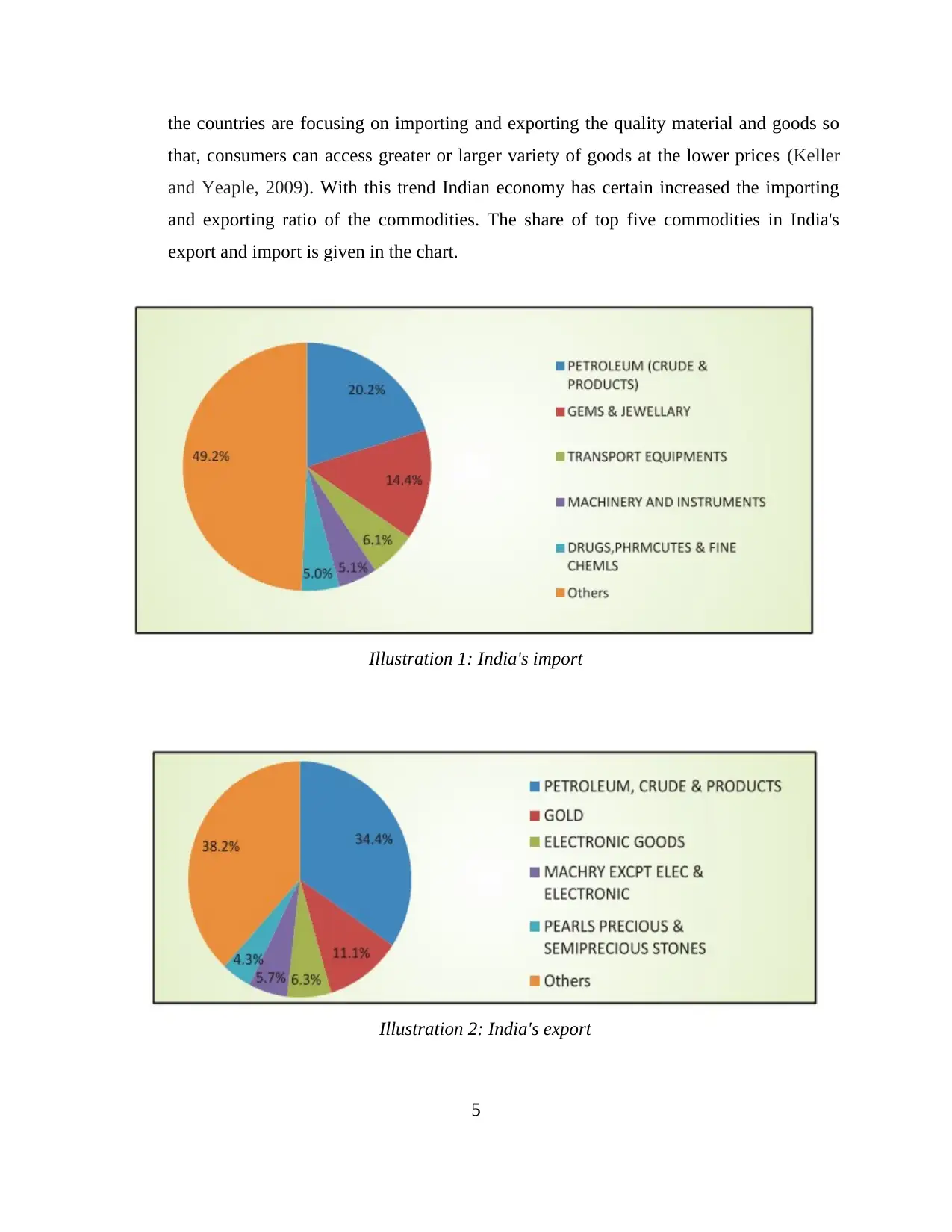
the countries are focusing on importing and exporting the quality material and goods so
that, consumers can access greater or larger variety of goods at the lower prices (Keller
and Yeaple, 2009). With this trend Indian economy has certain increased the importing
and exporting ratio of the commodities. The share of top five commodities in India's
export and import is given in the chart.
5
Illustration 1: India's import
Illustration 2: India's export
that, consumers can access greater or larger variety of goods at the lower prices (Keller
and Yeaple, 2009). With this trend Indian economy has certain increased the importing
and exporting ratio of the commodities. The share of top five commodities in India's
export and import is given in the chart.
5
Illustration 1: India's import
Illustration 2: India's export
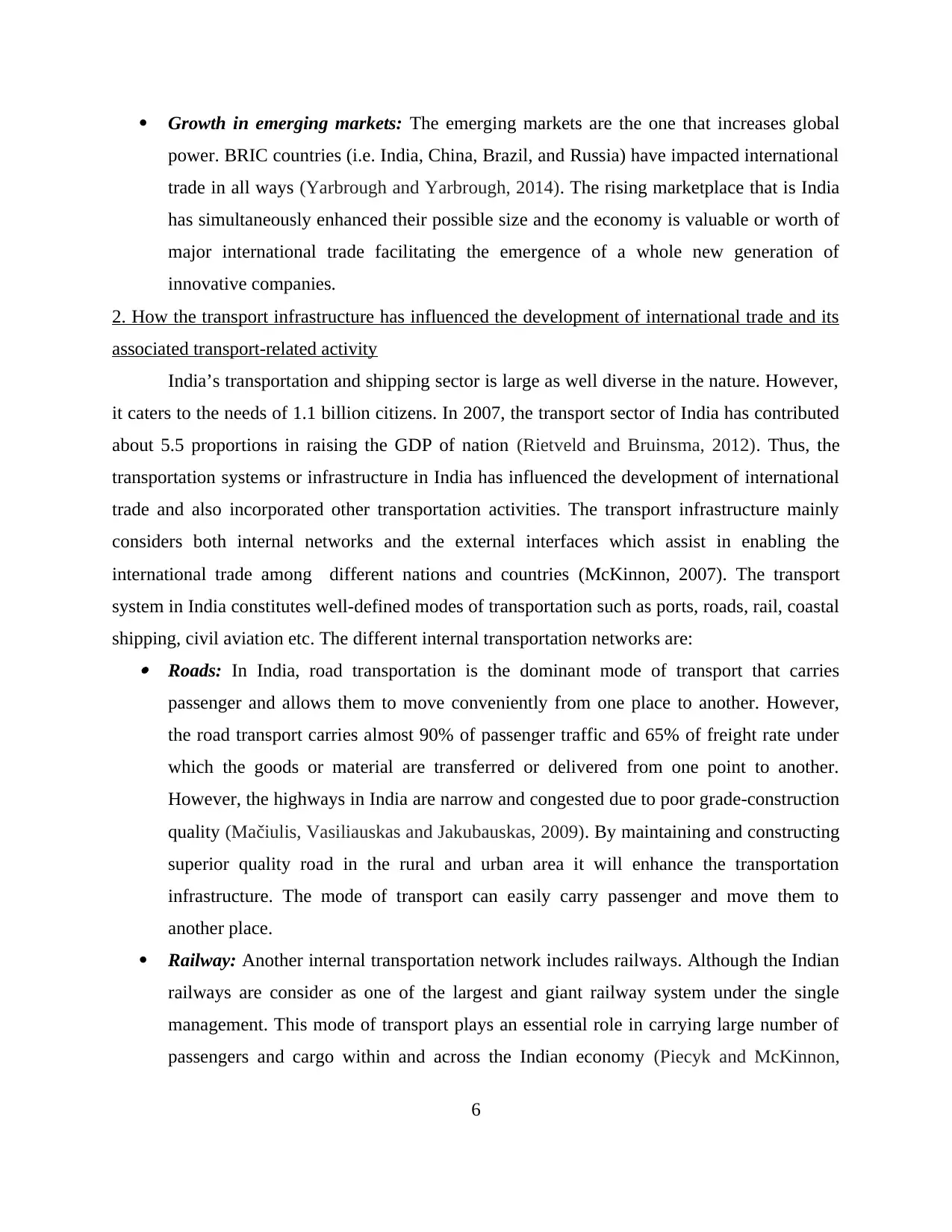
Growth in emerging markets: The emerging markets are the one that increases global
power. BRIC countries (i.e. India, China, Brazil, and Russia) have impacted international
trade in all ways (Yarbrough and Yarbrough, 2014). The rising marketplace that is India
has simultaneously enhanced their possible size and the economy is valuable or worth of
major international trade facilitating the emergence of a whole new generation of
innovative companies.
2. How the transport infrastructure has influenced the development of international trade and its
associated transport-related activity
India’s transportation and shipping sector is large as well diverse in the nature. However,
it caters to the needs of 1.1 billion citizens. In 2007, the transport sector of India has contributed
about 5.5 proportions in raising the GDP of nation (Rietveld and Bruinsma, 2012). Thus, the
transportation systems or infrastructure in India has influenced the development of international
trade and also incorporated other transportation activities. The transport infrastructure mainly
considers both internal networks and the external interfaces which assist in enabling the
international trade among different nations and countries (McKinnon, 2007). The transport
system in India constitutes well-defined modes of transportation such as ports, roads, rail, coastal
shipping, civil aviation etc. The different internal transportation networks are: Roads: In India, road transportation is the dominant mode of transport that carries
passenger and allows them to move conveniently from one place to another. However,
the road transport carries almost 90% of passenger traffic and 65% of freight rate under
which the goods or material are transferred or delivered from one point to another.
However, the highways in India are narrow and congested due to poor grade-construction
quality (Mačiulis, Vasiliauskas and Jakubauskas, 2009). By maintaining and constructing
superior quality road in the rural and urban area it will enhance the transportation
infrastructure. The mode of transport can easily carry passenger and move them to
another place.
Railway: Another internal transportation network includes railways. Although the Indian
railways are consider as one of the largest and giant railway system under the single
management. This mode of transport plays an essential role in carrying large number of
passengers and cargo within and across the Indian economy (Piecyk and McKinnon,
6
power. BRIC countries (i.e. India, China, Brazil, and Russia) have impacted international
trade in all ways (Yarbrough and Yarbrough, 2014). The rising marketplace that is India
has simultaneously enhanced their possible size and the economy is valuable or worth of
major international trade facilitating the emergence of a whole new generation of
innovative companies.
2. How the transport infrastructure has influenced the development of international trade and its
associated transport-related activity
India’s transportation and shipping sector is large as well diverse in the nature. However,
it caters to the needs of 1.1 billion citizens. In 2007, the transport sector of India has contributed
about 5.5 proportions in raising the GDP of nation (Rietveld and Bruinsma, 2012). Thus, the
transportation systems or infrastructure in India has influenced the development of international
trade and also incorporated other transportation activities. The transport infrastructure mainly
considers both internal networks and the external interfaces which assist in enabling the
international trade among different nations and countries (McKinnon, 2007). The transport
system in India constitutes well-defined modes of transportation such as ports, roads, rail, coastal
shipping, civil aviation etc. The different internal transportation networks are: Roads: In India, road transportation is the dominant mode of transport that carries
passenger and allows them to move conveniently from one place to another. However,
the road transport carries almost 90% of passenger traffic and 65% of freight rate under
which the goods or material are transferred or delivered from one point to another.
However, the highways in India are narrow and congested due to poor grade-construction
quality (Mačiulis, Vasiliauskas and Jakubauskas, 2009). By maintaining and constructing
superior quality road in the rural and urban area it will enhance the transportation
infrastructure. The mode of transport can easily carry passenger and move them to
another place.
Railway: Another internal transportation network includes railways. Although the Indian
railways are consider as one of the largest and giant railway system under the single
management. This mode of transport plays an essential role in carrying large number of
passengers and cargo within and across the Indian economy (Piecyk and McKinnon,
6
⊘ This is a preview!⊘
Do you want full access?
Subscribe today to unlock all pages.

Trusted by 1+ million students worldwide
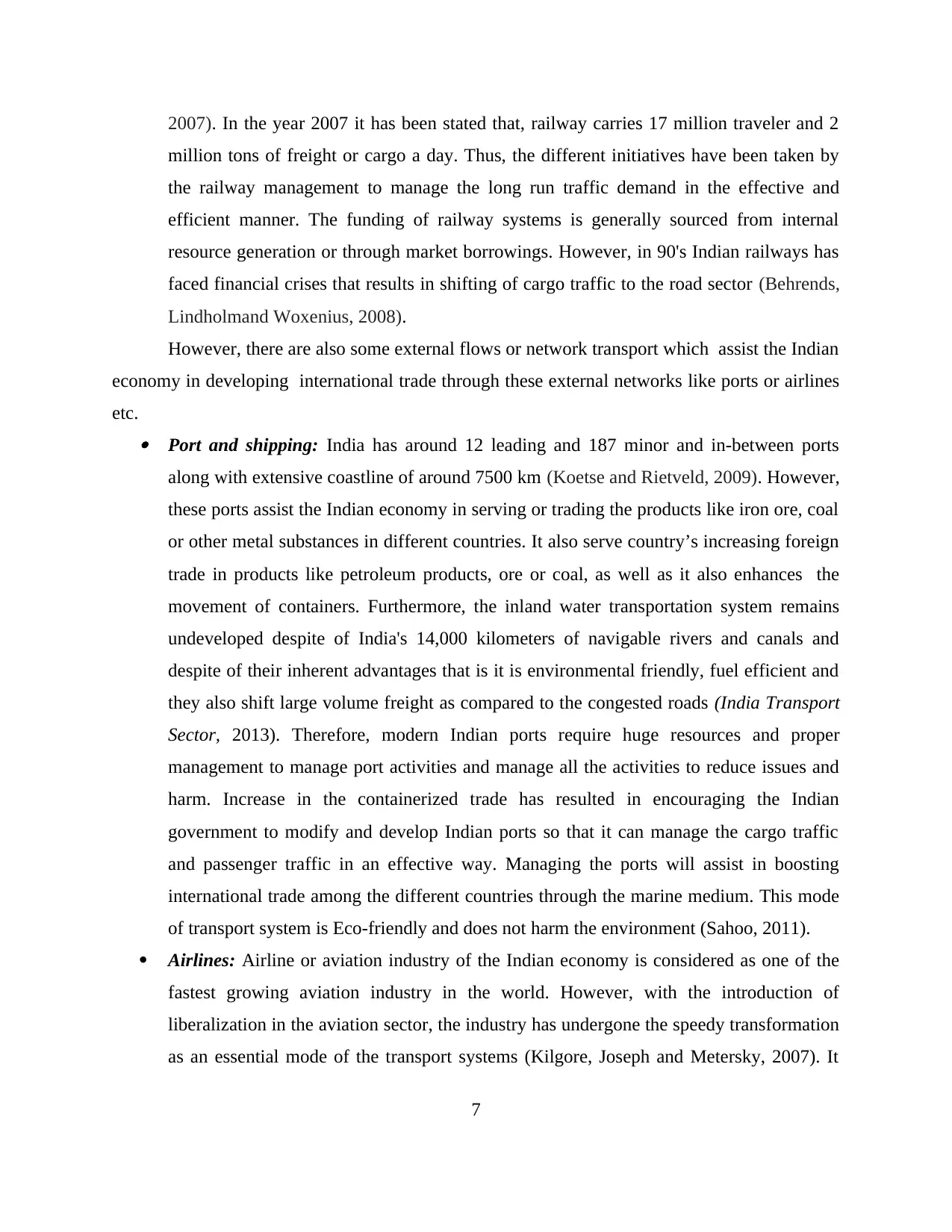
2007). In the year 2007 it has been stated that, railway carries 17 million traveler and 2
million tons of freight or cargo a day. Thus, the different initiatives have been taken by
the railway management to manage the long run traffic demand in the effective and
efficient manner. The funding of railway systems is generally sourced from internal
resource generation or through market borrowings. However, in 90's Indian railways has
faced financial crises that results in shifting of cargo traffic to the road sector (Behrends,
Lindholmand Woxenius, 2008).
However, there are also some external flows or network transport which assist the Indian
economy in developing international trade through these external networks like ports or airlines
etc. Port and shipping: India has around 12 leading and 187 minor and in-between ports
along with extensive coastline of around 7500 km (Koetse and Rietveld, 2009). However,
these ports assist the Indian economy in serving or trading the products like iron ore, coal
or other metal substances in different countries. It also serve country’s increasing foreign
trade in products like petroleum products, ore or coal, as well as it also enhances the
movement of containers. Furthermore, the inland water transportation system remains
undeveloped despite of India's 14,000 kilometers of navigable rivers and canals and
despite of their inherent advantages that is it is environmental friendly, fuel efficient and
they also shift large volume freight as compared to the congested roads (India Transport
Sector, 2013). Therefore, modern Indian ports require huge resources and proper
management to manage port activities and manage all the activities to reduce issues and
harm. Increase in the containerized trade has resulted in encouraging the Indian
government to modify and develop Indian ports so that it can manage the cargo traffic
and passenger traffic in an effective way. Managing the ports will assist in boosting
international trade among the different countries through the marine medium. This mode
of transport system is Eco-friendly and does not harm the environment (Sahoo, 2011).
Airlines: Airline or aviation industry of the Indian economy is considered as one of the
fastest growing aviation industry in the world. However, with the introduction of
liberalization in the aviation sector, the industry has undergone the speedy transformation
as an essential mode of the transport systems (Kilgore, Joseph and Metersky, 2007). It
7
million tons of freight or cargo a day. Thus, the different initiatives have been taken by
the railway management to manage the long run traffic demand in the effective and
efficient manner. The funding of railway systems is generally sourced from internal
resource generation or through market borrowings. However, in 90's Indian railways has
faced financial crises that results in shifting of cargo traffic to the road sector (Behrends,
Lindholmand Woxenius, 2008).
However, there are also some external flows or network transport which assist the Indian
economy in developing international trade through these external networks like ports or airlines
etc. Port and shipping: India has around 12 leading and 187 minor and in-between ports
along with extensive coastline of around 7500 km (Koetse and Rietveld, 2009). However,
these ports assist the Indian economy in serving or trading the products like iron ore, coal
or other metal substances in different countries. It also serve country’s increasing foreign
trade in products like petroleum products, ore or coal, as well as it also enhances the
movement of containers. Furthermore, the inland water transportation system remains
undeveloped despite of India's 14,000 kilometers of navigable rivers and canals and
despite of their inherent advantages that is it is environmental friendly, fuel efficient and
they also shift large volume freight as compared to the congested roads (India Transport
Sector, 2013). Therefore, modern Indian ports require huge resources and proper
management to manage port activities and manage all the activities to reduce issues and
harm. Increase in the containerized trade has resulted in encouraging the Indian
government to modify and develop Indian ports so that it can manage the cargo traffic
and passenger traffic in an effective way. Managing the ports will assist in boosting
international trade among the different countries through the marine medium. This mode
of transport system is Eco-friendly and does not harm the environment (Sahoo, 2011).
Airlines: Airline or aviation industry of the Indian economy is considered as one of the
fastest growing aviation industry in the world. However, with the introduction of
liberalization in the aviation sector, the industry has undergone the speedy transformation
as an essential mode of the transport systems (Kilgore, Joseph and Metersky, 2007). It
7
Paraphrase This Document
Need a fresh take? Get an instant paraphrase of this document with our AI Paraphraser
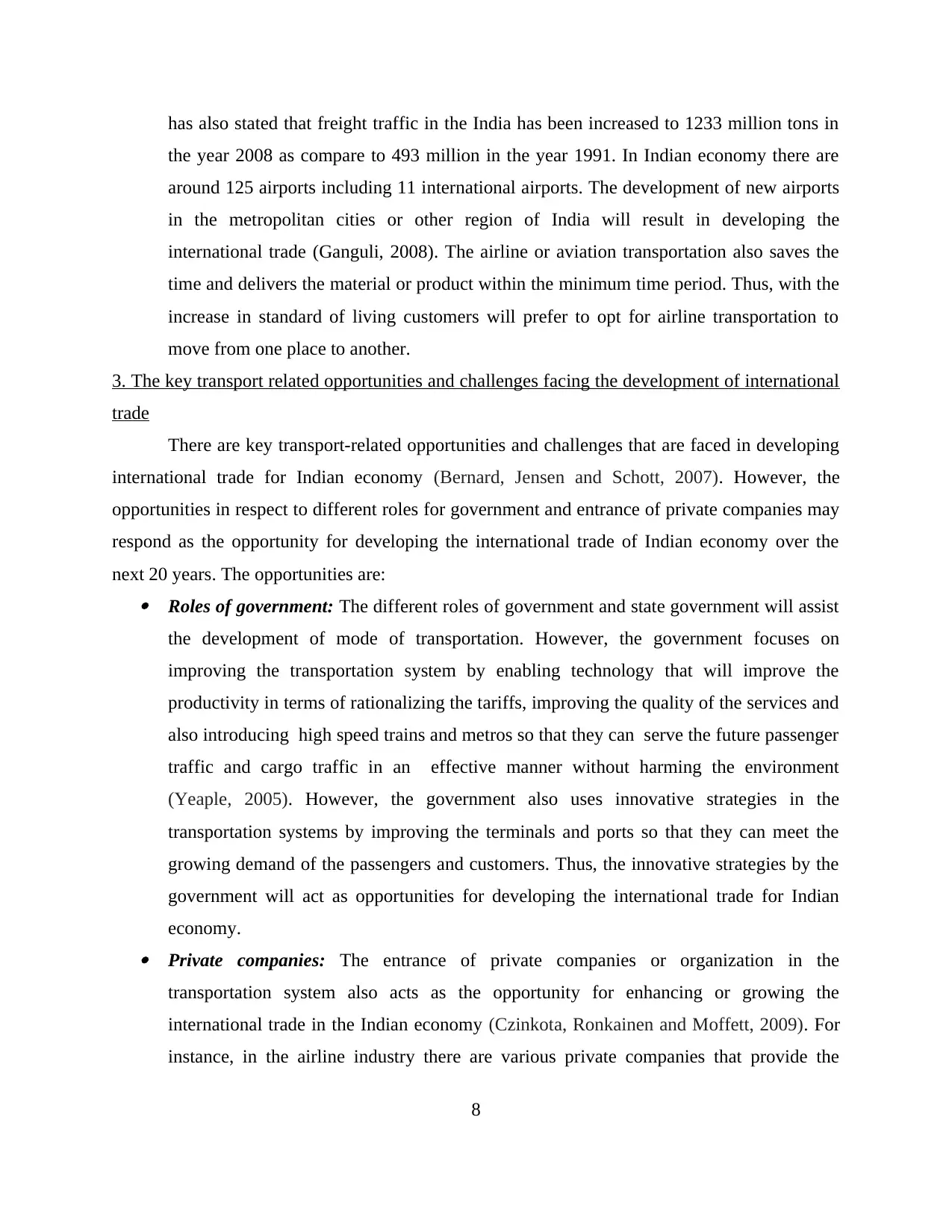
has also stated that freight traffic in the India has been increased to 1233 million tons in
the year 2008 as compare to 493 million in the year 1991. In Indian economy there are
around 125 airports including 11 international airports. The development of new airports
in the metropolitan cities or other region of India will result in developing the
international trade (Ganguli, 2008). The airline or aviation transportation also saves the
time and delivers the material or product within the minimum time period. Thus, with the
increase in standard of living customers will prefer to opt for airline transportation to
move from one place to another.
3. The key transport related opportunities and challenges facing the development of international
trade
There are key transport-related opportunities and challenges that are faced in developing
international trade for Indian economy (Bernard, Jensen and Schott, 2007). However, the
opportunities in respect to different roles for government and entrance of private companies may
respond as the opportunity for developing the international trade of Indian economy over the
next 20 years. The opportunities are: Roles of government: The different roles of government and state government will assist
the development of mode of transportation. However, the government focuses on
improving the transportation system by enabling technology that will improve the
productivity in terms of rationalizing the tariffs, improving the quality of the services and
also introducing high speed trains and metros so that they can serve the future passenger
traffic and cargo traffic in an effective manner without harming the environment
(Yeaple, 2005). However, the government also uses innovative strategies in the
transportation systems by improving the terminals and ports so that they can meet the
growing demand of the passengers and customers. Thus, the innovative strategies by the
government will act as opportunities for developing the international trade for Indian
economy. Private companies: The entrance of private companies or organization in the
transportation system also acts as the opportunity for enhancing or growing the
international trade in the Indian economy (Czinkota, Ronkainen and Moffett, 2009). For
instance, in the airline industry there are various private companies that provide the
8
the year 2008 as compare to 493 million in the year 1991. In Indian economy there are
around 125 airports including 11 international airports. The development of new airports
in the metropolitan cities or other region of India will result in developing the
international trade (Ganguli, 2008). The airline or aviation transportation also saves the
time and delivers the material or product within the minimum time period. Thus, with the
increase in standard of living customers will prefer to opt for airline transportation to
move from one place to another.
3. The key transport related opportunities and challenges facing the development of international
trade
There are key transport-related opportunities and challenges that are faced in developing
international trade for Indian economy (Bernard, Jensen and Schott, 2007). However, the
opportunities in respect to different roles for government and entrance of private companies may
respond as the opportunity for developing the international trade of Indian economy over the
next 20 years. The opportunities are: Roles of government: The different roles of government and state government will assist
the development of mode of transportation. However, the government focuses on
improving the transportation system by enabling technology that will improve the
productivity in terms of rationalizing the tariffs, improving the quality of the services and
also introducing high speed trains and metros so that they can serve the future passenger
traffic and cargo traffic in an effective manner without harming the environment
(Yeaple, 2005). However, the government also uses innovative strategies in the
transportation systems by improving the terminals and ports so that they can meet the
growing demand of the passengers and customers. Thus, the innovative strategies by the
government will act as opportunities for developing the international trade for Indian
economy. Private companies: The entrance of private companies or organization in the
transportation system also acts as the opportunity for enhancing or growing the
international trade in the Indian economy (Czinkota, Ronkainen and Moffett, 2009). For
instance, in the airline industry there are various private companies that provide the
8
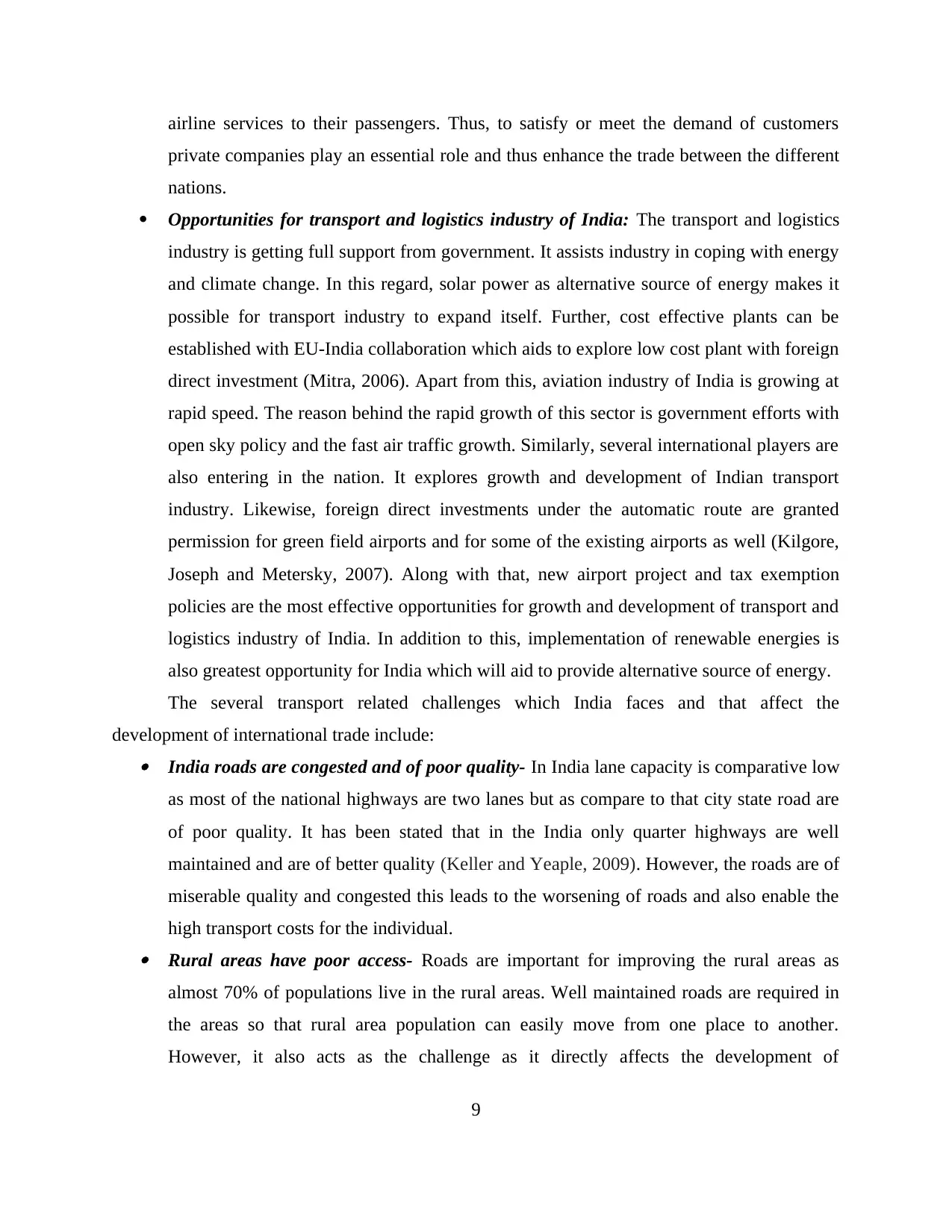
airline services to their passengers. Thus, to satisfy or meet the demand of customers
private companies play an essential role and thus enhance the trade between the different
nations.
Opportunities for transport and logistics industry of India: The transport and logistics
industry is getting full support from government. It assists industry in coping with energy
and climate change. In this regard, solar power as alternative source of energy makes it
possible for transport industry to expand itself. Further, cost effective plants can be
established with EU-India collaboration which aids to explore low cost plant with foreign
direct investment (Mitra, 2006). Apart from this, aviation industry of India is growing at
rapid speed. The reason behind the rapid growth of this sector is government efforts with
open sky policy and the fast air traffic growth. Similarly, several international players are
also entering in the nation. It explores growth and development of Indian transport
industry. Likewise, foreign direct investments under the automatic route are granted
permission for green field airports and for some of the existing airports as well (Kilgore,
Joseph and Metersky, 2007). Along with that, new airport project and tax exemption
policies are the most effective opportunities for growth and development of transport and
logistics industry of India. In addition to this, implementation of renewable energies is
also greatest opportunity for India which will aid to provide alternative source of energy.
The several transport related challenges which India faces and that affect the
development of international trade include: India roads are congested and of poor quality- In India lane capacity is comparative low
as most of the national highways are two lanes but as compare to that city state road are
of poor quality. It has been stated that in the India only quarter highways are well
maintained and are of better quality (Keller and Yeaple, 2009). However, the roads are of
miserable quality and congested this leads to the worsening of roads and also enable the
high transport costs for the individual. Rural areas have poor access- Roads are important for improving the rural areas as
almost 70% of populations live in the rural areas. Well maintained roads are required in
the areas so that rural area population can easily move from one place to another.
However, it also acts as the challenge as it directly affects the development of
9
private companies play an essential role and thus enhance the trade between the different
nations.
Opportunities for transport and logistics industry of India: The transport and logistics
industry is getting full support from government. It assists industry in coping with energy
and climate change. In this regard, solar power as alternative source of energy makes it
possible for transport industry to expand itself. Further, cost effective plants can be
established with EU-India collaboration which aids to explore low cost plant with foreign
direct investment (Mitra, 2006). Apart from this, aviation industry of India is growing at
rapid speed. The reason behind the rapid growth of this sector is government efforts with
open sky policy and the fast air traffic growth. Similarly, several international players are
also entering in the nation. It explores growth and development of Indian transport
industry. Likewise, foreign direct investments under the automatic route are granted
permission for green field airports and for some of the existing airports as well (Kilgore,
Joseph and Metersky, 2007). Along with that, new airport project and tax exemption
policies are the most effective opportunities for growth and development of transport and
logistics industry of India. In addition to this, implementation of renewable energies is
also greatest opportunity for India which will aid to provide alternative source of energy.
The several transport related challenges which India faces and that affect the
development of international trade include: India roads are congested and of poor quality- In India lane capacity is comparative low
as most of the national highways are two lanes but as compare to that city state road are
of poor quality. It has been stated that in the India only quarter highways are well
maintained and are of better quality (Keller and Yeaple, 2009). However, the roads are of
miserable quality and congested this leads to the worsening of roads and also enable the
high transport costs for the individual. Rural areas have poor access- Roads are important for improving the rural areas as
almost 70% of populations live in the rural areas. Well maintained roads are required in
the areas so that rural area population can easily move from one place to another.
However, it also acts as the challenge as it directly affects the development of
9
⊘ This is a preview!⊘
Do you want full access?
Subscribe today to unlock all pages.

Trusted by 1+ million students worldwide
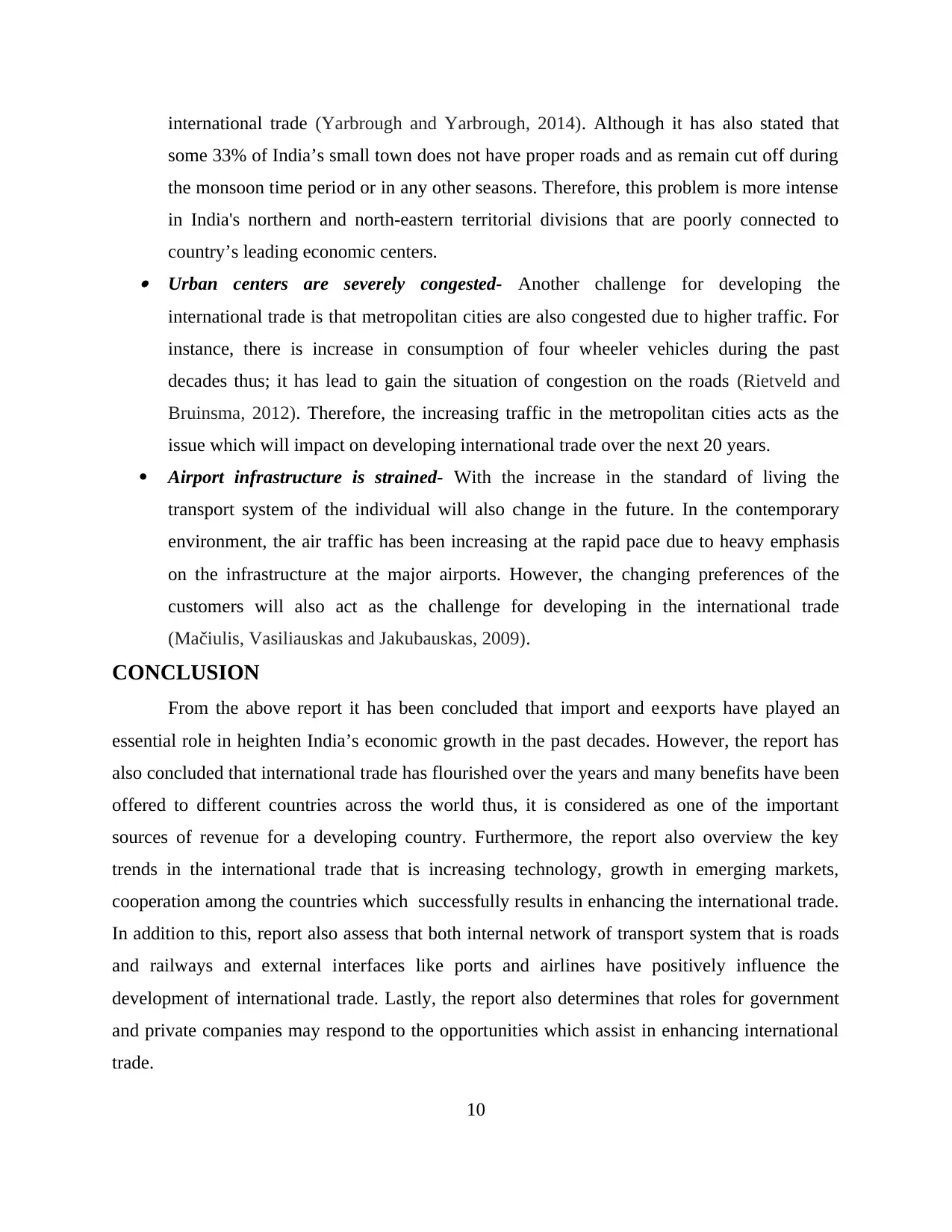
international trade (Yarbrough and Yarbrough, 2014). Although it has also stated that
some 33% of India’s small town does not have proper roads and as remain cut off during
the monsoon time period or in any other seasons. Therefore, this problem is more intense
in India's northern and north-eastern territorial divisions that are poorly connected to
country’s leading economic centers. Urban centers are severely congested- Another challenge for developing the
international trade is that metropolitan cities are also congested due to higher traffic. For
instance, there is increase in consumption of four wheeler vehicles during the past
decades thus; it has lead to gain the situation of congestion on the roads (Rietveld and
Bruinsma, 2012). Therefore, the increasing traffic in the metropolitan cities acts as the
issue which will impact on developing international trade over the next 20 years.
Airport infrastructure is strained- With the increase in the standard of living the
transport system of the individual will also change in the future. In the contemporary
environment, the air traffic has been increasing at the rapid pace due to heavy emphasis
on the infrastructure at the major airports. However, the changing preferences of the
customers will also act as the challenge for developing in the international trade
(Mačiulis, Vasiliauskas and Jakubauskas, 2009).
CONCLUSION
From the above report it has been concluded that import and eexports have played an
essential role in heighten India’s economic growth in the past decades. However, the report has
also concluded that international trade has flourished over the years and many benefits have been
offered to different countries across the world thus, it is considered as one of the important
sources of revenue for a developing country. Furthermore, the report also overview the key
trends in the international trade that is increasing technology, growth in emerging markets,
cooperation among the countries which successfully results in enhancing the international trade.
In addition to this, report also assess that both internal network of transport system that is roads
and railways and external interfaces like ports and airlines have positively influence the
development of international trade. Lastly, the report also determines that roles for government
and private companies may respond to the opportunities which assist in enhancing international
trade.
10
some 33% of India’s small town does not have proper roads and as remain cut off during
the monsoon time period or in any other seasons. Therefore, this problem is more intense
in India's northern and north-eastern territorial divisions that are poorly connected to
country’s leading economic centers. Urban centers are severely congested- Another challenge for developing the
international trade is that metropolitan cities are also congested due to higher traffic. For
instance, there is increase in consumption of four wheeler vehicles during the past
decades thus; it has lead to gain the situation of congestion on the roads (Rietveld and
Bruinsma, 2012). Therefore, the increasing traffic in the metropolitan cities acts as the
issue which will impact on developing international trade over the next 20 years.
Airport infrastructure is strained- With the increase in the standard of living the
transport system of the individual will also change in the future. In the contemporary
environment, the air traffic has been increasing at the rapid pace due to heavy emphasis
on the infrastructure at the major airports. However, the changing preferences of the
customers will also act as the challenge for developing in the international trade
(Mačiulis, Vasiliauskas and Jakubauskas, 2009).
CONCLUSION
From the above report it has been concluded that import and eexports have played an
essential role in heighten India’s economic growth in the past decades. However, the report has
also concluded that international trade has flourished over the years and many benefits have been
offered to different countries across the world thus, it is considered as one of the important
sources of revenue for a developing country. Furthermore, the report also overview the key
trends in the international trade that is increasing technology, growth in emerging markets,
cooperation among the countries which successfully results in enhancing the international trade.
In addition to this, report also assess that both internal network of transport system that is roads
and railways and external interfaces like ports and airlines have positively influence the
development of international trade. Lastly, the report also determines that roles for government
and private companies may respond to the opportunities which assist in enhancing international
trade.
10
Paraphrase This Document
Need a fresh take? Get an instant paraphrase of this document with our AI Paraphraser

11
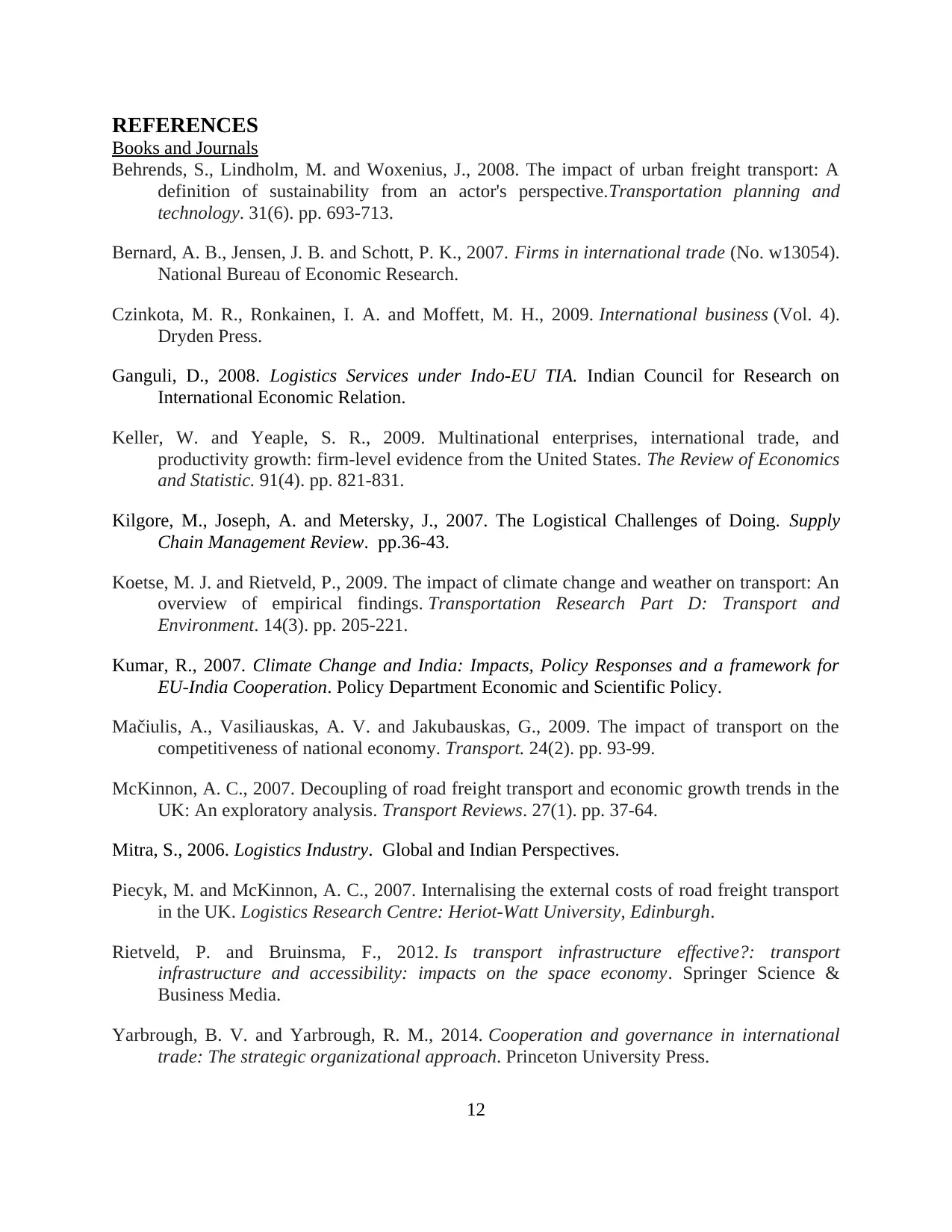
REFERENCES
Books and Journals
Behrends, S., Lindholm, M. and Woxenius, J., 2008. The impact of urban freight transport: A
definition of sustainability from an actor's perspective.Transportation planning and
technology. 31(6). pp. 693-713.
Bernard, A. B., Jensen, J. B. and Schott, P. K., 2007. Firms in international trade (No. w13054).
National Bureau of Economic Research.
Czinkota, M. R., Ronkainen, I. A. and Moffett, M. H., 2009. International business (Vol. 4).
Dryden Press.
Ganguli, D., 2008. Logistics Services under Indo-EU TIA. Indian Council for Research on
International Economic Relation.
Keller, W. and Yeaple, S. R., 2009. Multinational enterprises, international trade, and
productivity growth: firm-level evidence from the United States. The Review of Economics
and Statistic. 91(4). pp. 821-831.
Kilgore, M., Joseph, A. and Metersky, J., 2007. The Logistical Challenges of Doing. Supply
Chain Management Review. pp.36-43.
Koetse, M. J. and Rietveld, P., 2009. The impact of climate change and weather on transport: An
overview of empirical findings. Transportation Research Part D: Transport and
Environment. 14(3). pp. 205-221.
Kumar, R., 2007. Climate Change and India: Impacts, Policy Responses and a framework for
EU-India Cooperation. Policy Department Economic and Scientific Policy.
Mačiulis, A., Vasiliauskas, A. V. and Jakubauskas, G., 2009. The impact of transport on the
competitiveness of national economy. Transport. 24(2). pp. 93-99.
McKinnon, A. C., 2007. Decoupling of road freight transport and economic growth trends in the
UK: An exploratory analysis. Transport Reviews. 27(1). pp. 37-64.
Mitra, S., 2006. Logistics Industry. Global and Indian Perspectives.
Piecyk, M. and McKinnon, A. C., 2007. Internalising the external costs of road freight transport
in the UK. Logistics Research Centre: Heriot-Watt University, Edinburgh.
Rietveld, P. and Bruinsma, F., 2012. Is transport infrastructure effective?: transport
infrastructure and accessibility: impacts on the space economy. Springer Science &
Business Media.
Yarbrough, B. V. and Yarbrough, R. M., 2014. Cooperation and governance in international
trade: The strategic organizational approach. Princeton University Press.
12
Books and Journals
Behrends, S., Lindholm, M. and Woxenius, J., 2008. The impact of urban freight transport: A
definition of sustainability from an actor's perspective.Transportation planning and
technology. 31(6). pp. 693-713.
Bernard, A. B., Jensen, J. B. and Schott, P. K., 2007. Firms in international trade (No. w13054).
National Bureau of Economic Research.
Czinkota, M. R., Ronkainen, I. A. and Moffett, M. H., 2009. International business (Vol. 4).
Dryden Press.
Ganguli, D., 2008. Logistics Services under Indo-EU TIA. Indian Council for Research on
International Economic Relation.
Keller, W. and Yeaple, S. R., 2009. Multinational enterprises, international trade, and
productivity growth: firm-level evidence from the United States. The Review of Economics
and Statistic. 91(4). pp. 821-831.
Kilgore, M., Joseph, A. and Metersky, J., 2007. The Logistical Challenges of Doing. Supply
Chain Management Review. pp.36-43.
Koetse, M. J. and Rietveld, P., 2009. The impact of climate change and weather on transport: An
overview of empirical findings. Transportation Research Part D: Transport and
Environment. 14(3). pp. 205-221.
Kumar, R., 2007. Climate Change and India: Impacts, Policy Responses and a framework for
EU-India Cooperation. Policy Department Economic and Scientific Policy.
Mačiulis, A., Vasiliauskas, A. V. and Jakubauskas, G., 2009. The impact of transport on the
competitiveness of national economy. Transport. 24(2). pp. 93-99.
McKinnon, A. C., 2007. Decoupling of road freight transport and economic growth trends in the
UK: An exploratory analysis. Transport Reviews. 27(1). pp. 37-64.
Mitra, S., 2006. Logistics Industry. Global and Indian Perspectives.
Piecyk, M. and McKinnon, A. C., 2007. Internalising the external costs of road freight transport
in the UK. Logistics Research Centre: Heriot-Watt University, Edinburgh.
Rietveld, P. and Bruinsma, F., 2012. Is transport infrastructure effective?: transport
infrastructure and accessibility: impacts on the space economy. Springer Science &
Business Media.
Yarbrough, B. V. and Yarbrough, R. M., 2014. Cooperation and governance in international
trade: The strategic organizational approach. Princeton University Press.
12
⊘ This is a preview!⊘
Do you want full access?
Subscribe today to unlock all pages.

Trusted by 1+ million students worldwide
1 out of 13
Related Documents
Your All-in-One AI-Powered Toolkit for Academic Success.
+13062052269
info@desklib.com
Available 24*7 on WhatsApp / Email
![[object Object]](/_next/static/media/star-bottom.7253800d.svg)
Unlock your academic potential
Copyright © 2020–2025 A2Z Services. All Rights Reserved. Developed and managed by ZUCOL.




